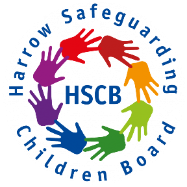Voice of the Child
 At Harrow SCB the Child’s Voice is a phrase we use to describe the real involvement of children and young people. It means more than seeking their views, which could just mean the child saying what they want, rather than being really involved in what happens. Lord Laming said of Victoria Climbié that no-one could describe a day in her life. Children and young people should have the opportunity to describe things from their point of view. They should be continually involved, and have information fed back to them in a way that they can understand. There should always be evidence that their voice has influenced the decisions that professionals have made. We want to develop this across the harrow partnership to improve the safeguarding of children in Harrow.
At Harrow SCB the Child’s Voice is a phrase we use to describe the real involvement of children and young people. It means more than seeking their views, which could just mean the child saying what they want, rather than being really involved in what happens. Lord Laming said of Victoria Climbié that no-one could describe a day in her life. Children and young people should have the opportunity to describe things from their point of view. They should be continually involved, and have information fed back to them in a way that they can understand. There should always be evidence that their voice has influenced the decisions that professionals have made. We want to develop this across the harrow partnership to improve the safeguarding of children in Harrow.
At the 2016 HSCB annual conference for professionals focusing on vulnerable young people was a good example of the involvement of the voice of children and young people. We had workshops led by children, case studies based on the voice of children and questions to engage participants that focused on the voice of the child. We want to take further steps to ensure that the voice of the child permeates all our work and our partners to improve outcomes for children in Harrow.
 The Munro Review of Child Protection (2010) set out 8 principles which together to make a good child protection system. The first is that the system should be centred on the child: everyone involved in child protection should focus on children and young people, respecting them as individuals with rights, including having a say in decisions about them whenever they are capable of giving their views.
The Munro Review of Child Protection (2010) set out 8 principles which together to make a good child protection system. The first is that the system should be centred on the child: everyone involved in child protection should focus on children and young people, respecting them as individuals with rights, including having a say in decisions about them whenever they are capable of giving their views.
Article 12 of the UN Convention on the Rights of the Child states that children and young people have a right to say what they think should happen, when adults are making decisions that affect them, and to have their opinions taken into account. It is also found in many of our laws (like the Children Act 1989, the Human Rights Act 1998, the Children Act 2004 and, more recently, the Children and Young Persons Act 2008).

Of all the rights that children now have the one they rate the most is the right to protection from abuse. Children and young people have told adult time and time again that what they value most are good relationships with professionals they can trust and practice that focuses on their needs. Building a trusting relationship with professionals is seen as important as it provides children with ways of getting information, knowing about their rights, having their say and making choices, and finding out how decisions about them are being made.
Spending time with children, talking to them, and making sure that you are actively listening and taking seriously what they say is an essential safeguarding activity. NCB Communicating with Children 2006
What Ofsted found (these are inspectors of schools, childrens homes, foster care and other services for children) taken from ˜The voice of the child: learning lessons from serious case reviews; A thematic report of Ofsteds evaluation of serious case reviews from 1 April to 30 September 2010
A common criticism in reports of inquiries/reviews into child deaths is that people did not speak to the children enough. And, the importance of listening to the child continues to be repeated in serious case reviews (these are reviews that are usually carried out when a child has died or been badly hurt as a result of abuse or neglect). The report highlights five main messages with respect to the voice of the child:
- The child was not seen often enough by the professionals involved, or was never asked their views and feelings
- Agencies did not listen to adults (such as advocates or teachers) who tried to speak up on behalf of the child and who had important information to give
- Parents (or carers) stopped professionals from seeing and listening to the child
- Workers paid too much attention to the needs of the parents, and not enough on the needs of the child
- Agencies did not understand well enough what was going on to protect the child
Harrow SCB will create a dissemination strategy to develop our commitment to hearing the voices of all children and young people in Harrow. We will bring together good practice from within Harrow and elsewhere to demonstrate to the wider partnership on how to plan, deliver and improve the participation of children and young people in the services that matter to them. We will do this through a series of sector based meetings and workshops. By improving the way we engage with children and young people and listen to them we hope to strengthen their voices in the safeguarding arena too. We will also adopt some of these practices to better engage the voice of children and young people in our work. We will communicate our plans on this website and via our networks across the Harrow partnership.
Until we gather our evidence of good practice from across Harrow on effective engagement and listening to the voices of children and young people we will make use of the practice guidelines previously developed by Bath and North East Somerset Council.
- Children feel listened to
- When children are involved, plans are more successful
- We can see their experience, from their point of view
- Children can develop their own story about what is happening in their lives
- Get to know us; spend time with us and give us your attention
- Dont get us to repeat our story over and over again
- Keep us at the centre of the decisions you make
- Be honest with us and explain in a way we can understand
- Let us make some decisions about our own life
- Dont make assumptions about our thoughts and feelings
- Children are less safe
- Children are less happy and their wellbeing is lower
- Children become less visible; adult needs can dominate
- Assumptions are made about childrens lives
- Knowledge about children is limited to their relationships with adults
- Take time to know the young person you are working with, what they enjoy, what are their concerns and what are their ambitions and aspirations
- Document the child or young persons journey from needing help, to receiving help ¢ Record the child or young persons wishes and feelings
- Observe and record their behaviour and experiences
- Ask other professionals for their knowledge of the child or young person as they may have significantly more contact with the child
- Evidence the Childs Voice throughout Single Assessment (Social Work assessment section pg.5); throughout Section 47 Assessment (social work assessment pg.6; reason for service pg.3 and pg. 7); throughout CIN Plan Review (plan and review section) and throughout Children in Care Plan Review
- Thread the Childs Voice through all recording; creative activities used to listen to children and young people can be kept on record in one place
- Record how rapport has been built with children and young people and the activities you have done together; relationships matter
- Record the child or young persons journey through Social Care.
- Gather Feedback from children and young people throughout an intervention, and not just at the end of an intervention.
- Keep children and young people appropriately involved in a realistic way. Age and stage needs to be taken into account.
- Acknowledge the reality of the childs life, with the child directly. For example, it may not be possible for the child to return home, but they can be involved in other decisions about their life, including the important day to day decisions (which increase a childs agency helping them to regain some control, and develop resilience skills). For children who need additional help, every day matters. (Working Together 13). The little things can really matter.
- Demonstrate an active interest in the child or young persons life, their views, aspirations interests and activities, and undertake those activities with the child.
- Identify what is important to the child or young person, and what is important for the child or young person.
- Record how the child or young person interacts with other people, in different settings and at different times (of day, before and after placement). At times appropriate to the child.
- Record a childs development needs.
- The difficult and painful issues need to be recorded, along with how these issues can be addressed.
- Adult fears and expectations around involving children and young people are acknowledged and managed.
- The context and challenges for evidencing the Childs Voice is recognised; it can be harder to implement consistently in crisis work.
- Making the child or young person central to the story being told. Ensuring they feel important.
- The child or young person should jump off the page.
- Child centred thinking.
- No child is too young to have a voice. Involve the child regardless of age.
- Creative methods used to involve the child or young person, meeting their learning and development needs, and their preferences.
- Co-production of plans, assessment and reviews; children and young people can participate in producing essential documents about their lives.
- Involving the child or young person is a continual process that needs reviewing as the child changes and develops.
- The child or young person shouldnt have to tell their story over and over again. Practitioners need to read was have already been written.
- Ownership and commitment across the structure through managers, social workers and assistants.
- Sharing understanding and meaning of the Childs Voice across agencies. Other agencies will spend more time with the child and they need to be involved and recording the Childs Voice.
- Not rushing contact with the child; even if you only have limited time, focus on them. Children and young people should not know how busy you are, or how many other meetings you need to attend.
- Managing how you leave a child or young person after a hard moment.
- Drawing a picture of the child or young persons day to capture what their day is like.
- If a profile format including what the child looks like, their likes and dislikes, their personality, their fears and what makes their day good. This format is more than a form to fill in.
- Having a real understanding of what makes a child or young persons day good or not so good. What is a good start to their day? This links to their specific likes and dislikes.
- Enabling choice for the child or young person. Where do they want to meet their worker?
- Feedback from the child or young person on the value of being included and involved is essential. This can also support professional and practice development.
- Recording the journey travelled; achievement and attainment is more than standard (national) indicators.
- Endings are important and need to be planned for.
- With the Childs Voice well evidenced, handover between social workers and other child care professionals is improved.


